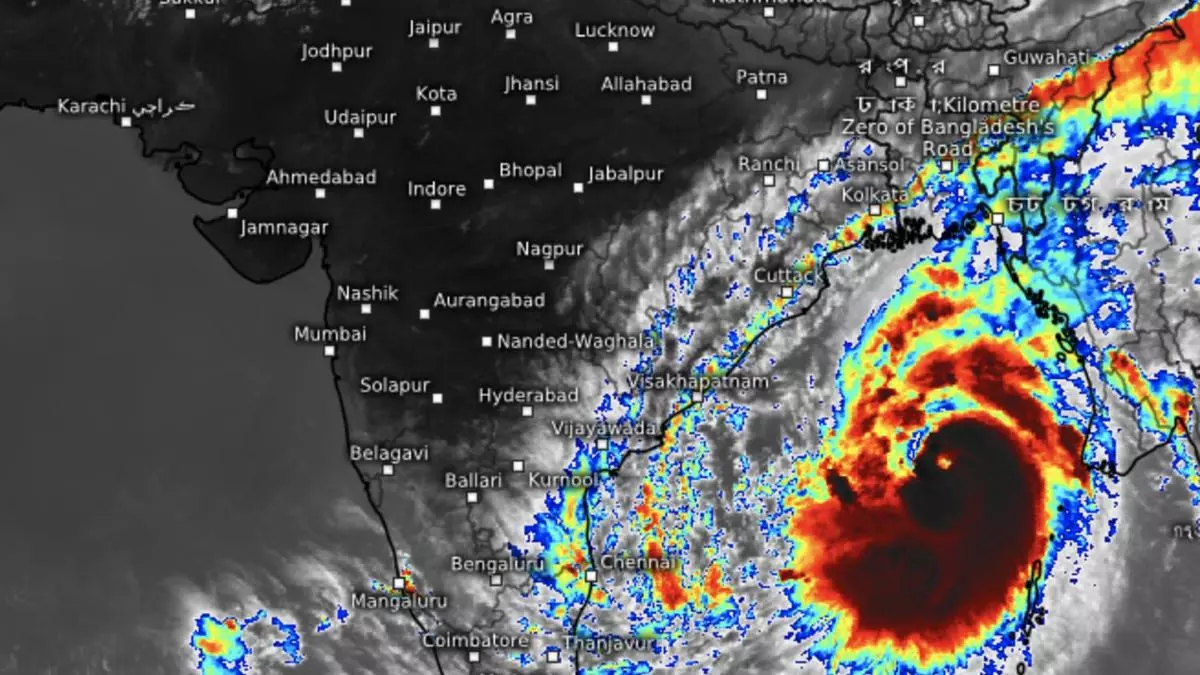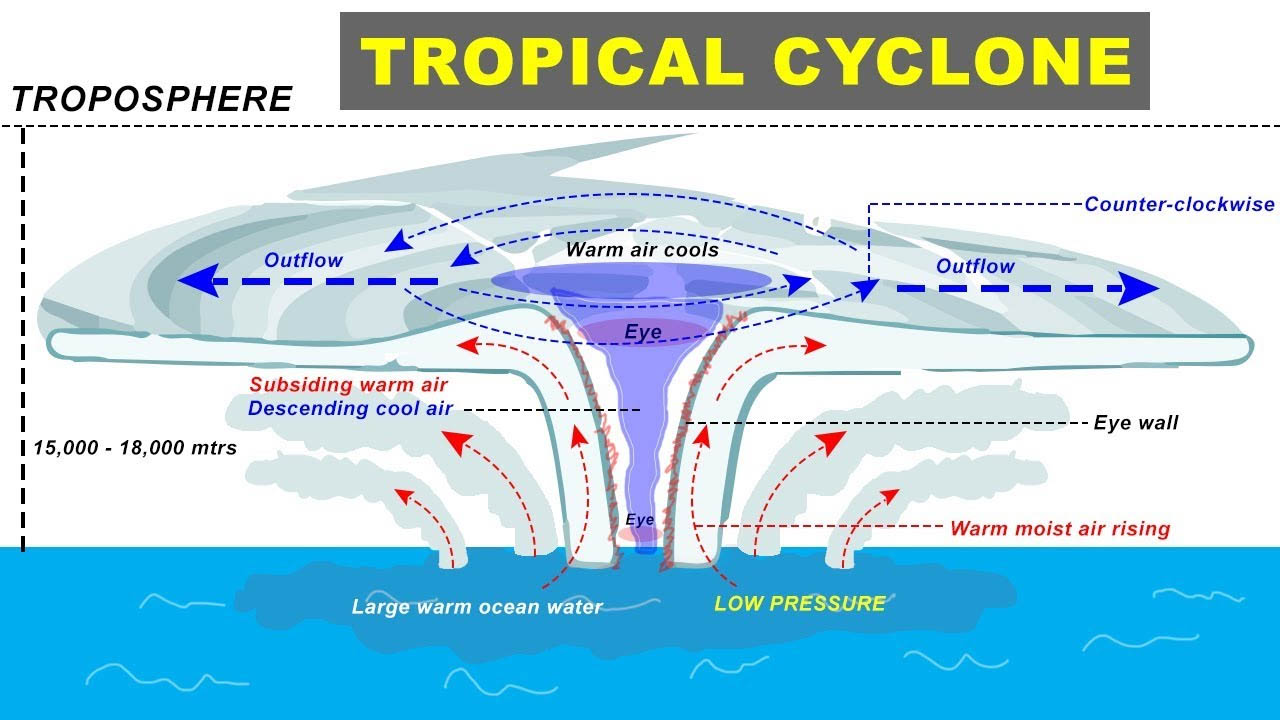Geography
Cyclone Mocha
- 16 May 2023
- 8 min read
For Prelims: Cyclone Mocha, IMD, Cyclone, Amphan, Tauktae, WMO, Monsoon.
For Mains: Cyclone, its types and Occurrence of Cyclone in India.
Why in News?
Cyclone Mocha that made landfall recently in Myanmar has been categorized as an Extremely Severe Cyclonic Storm by the IMD (Indian Meteorological Department) and as a ‘Super Cyclone’ by global weather website Zoom Earth.
- It became the strongest cyclone on earth so far in 2023 according to Typhoon Research Center in South Korea’s Jeju National University.
- There have been 16 cyclones so far this year in both Northern and Southern Hemispheres.
What is Mocha?
- Naming:
- Yemen suggested the name ‘Mocha', which is supposed to be pronounced as Mokha.
- The cyclone has been named after a Red Sea port city known for its coffee production. The city also gave its name to the popular beverage, café Mocha
- Origin:
- It originated in the Bay of Bengal.
- Intensity:
- With a recorded wind speed of 277 kmph, Mocha became the strongest cyclone for all seasons in both Arabian Sea and Bay of Bengal, since 1982, in the North Indian Ocean, tying with Cyclone Fani in terms of speed and intensity.
- Amphan, witnessed in 2020, was 268 kmph while Tauktae in 2021 it was 222 kmph and Gonu in 2007 recorded a speed of 268 kmph.
- With a recorded wind speed of 277 kmph, Mocha became the strongest cyclone for all seasons in both Arabian Sea and Bay of Bengal, since 1982, in the North Indian Ocean, tying with Cyclone Fani in terms of speed and intensity.
What is a Cyclone?
- About:
- Cyclones are rapid inward air circulation around a low-pressure area. The air circulates in an anticlockwise direction in the Northern hemisphere and clockwise in the Southern hemisphere.
- Cyclones are usually accompanied by violent storms and bad weather.
- The word Cyclone is derived from the Greek word Cyclos meaning the coils of a snake. It was coined by Henry Peddington because the tropical storms in the Bay of Bengal and the Arabian Sea appear like coiled serpents of the sea.
- Types:
- Tropical Cyclones: The World Meteorological Organisation (WMO) uses the term 'Tropical Cyclone’ to cover weather systems in which winds exceed ‘Gale Force’ (minimum of 63 km per hour).
- Tropical cyclones develop in the region between the Tropics of Capricorn and Cancer.
- Extra Tropical cyclones: They are also called Temperate cyclones or middle latitude cyclones or Frontal cyclones or Wave Cyclones.
- They occur in temperate zones and high latitude regions, though they are known to originate in the Polar Regions.
- Tropical Cyclones: The World Meteorological Organisation (WMO) uses the term 'Tropical Cyclone’ to cover weather systems in which winds exceed ‘Gale Force’ (minimum of 63 km per hour).
What are Tropical Cyclones?
- About:
- A tropical cyclone is an intense circular storm that originates over warm tropical oceans and is characterized by low atmospheric pressure, high winds, and heavy rain.
- A characteristic feature of tropical cyclones is the eye, a central region of clear skies, warm temperatures, and low atmospheric pressure.
- Storms of this type are called hurricanes in the North Atlantic and eastern Pacific and typhoons in SouthEast Asia and China. They are called tropical cyclones in the southwest Pacific and Indian Ocean region and Willy-willies in north-western Australia.
- Storms rotate counterclockwise in the northern hemisphere and clockwise in the southern hemisphere.
- Conditions for Formation:
- The conditions favourable for the formation and intensification of tropical storms are:
- Large sea surface with temperature higher than 27° C.
- Presence of the Coriolis force.
- Small variations in the vertical wind speed.
- A pre-existing weak low- pressure area or low-level-cyclonic circulation.
- Upper divergence above the sea level system.
- The conditions favourable for the formation and intensification of tropical storms are:
How are Low-Pressure Systems Classified based on their Intensity?
- The IMD has developed criteria for classifying low-pressure systems in the Bay of Bengal and the Arabian Sea based on their potential for causing damage which have been adopted by the WMO.
Note: 1 knot - 1.85 km per hour
How are Names of Cyclones Decided?
- Cyclones that form in every ocean basin across the world are named by the regional specialised meteorological centres (RSMCs) and Tropical Cyclone Warning Centres (TCWCs).
- There are six RSMCs in the world, including the India Meteorological Department (IMD), and five TCWCs.
- In 2000, a group of nations called WMO/ESCAP (World Meteorological Organisation/United Nations Economic and Social Commission for Asia and the Pacific), which comprised Bangladesh, India, the Maldives, Myanmar, Oman, Pakistan, Sri Lanka and Thailand, decided to start naming cyclones in the region.
- After each country sent in suggestions, the WMO/ESCAP Panel on Tropical Cyclones (PTC) finalised the list.
- The WMO/ESCAP expanded to include five more countries in 2018 — Iran, Qatar, Saudi Arabia, United Arab Emirates and Yemen.
What is the Occurrence of Cyclones in India?
- India has a bi-annual cyclone season that occurs between March to May and October to December. But on rare occasions, cyclones do occur in June and September months.
- Typically, tropical cyclones in the North Indian Ocean region (Bay of Bengal and Arabian Sea) develop during the pre-monsoon (April to June) and post-monsoon (October to December) periods.
- May-June and October-November are known to produce cyclones of severe intensity that affect the Indian coasts.
UPSC Civil Services Examination, Previous Year Questions (PYQs)
Prelims
Q. In the South Atlantic and South-Eastern Pacific regions in tropical latitudes, cyclone does not originate. What is the reason? (2015)
(a) Sea surface temperatures are low
(b) Inter-Tropical Convergence Zone seldom occurs
(c) Coriolis force is too weak
(d) Absence of land in those regions
Ans: (b)
Ans:
- The most proximate reasons for the lack of cyclones in the South Atlantic and South Eastern Pacific ocean is the rare occurrence of the Inter-Tropical Convergence Zone (ITCZ) over the region.
- It becomes very difficult or nearly impossible to have genesis of tropical cyclones, unless synoptic vorticity (it is a clockwise or counterclockwise spin in the troposphere) and convergence (i.e., large scale spin and thunderstorm activity) are provided by ITCZ.
- Therefore, option (b) is the correct answer.
Mains
Q. The recent cyclone on the east coast of India was called “Phailin”. How are the tropical cyclones named across the world? Elaborate. (2013)
Q. Discuss the meaning of colour-coded weather warnings for cyclone prone areas given by India Meteorological Department. (2022)









